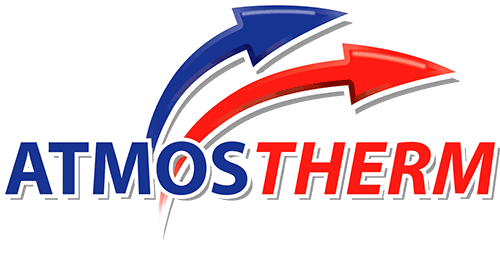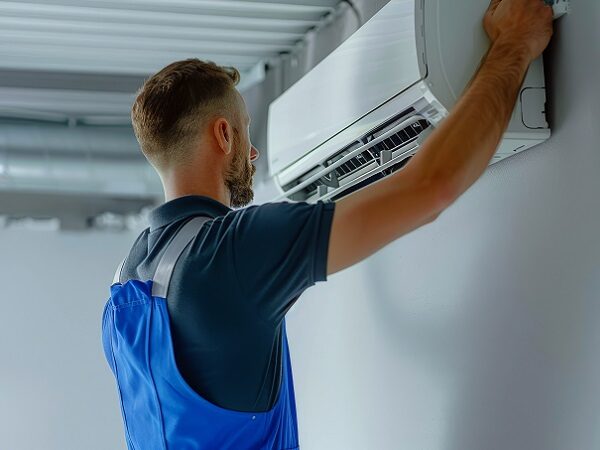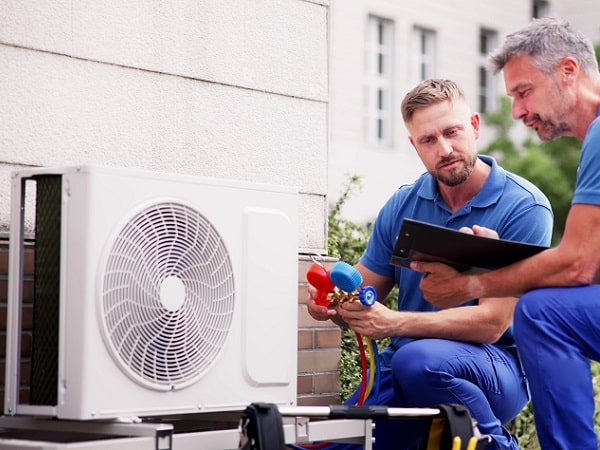Atmostherm’s Ultimate Guide to Commercial HVAC Systems
When commercial heating, ventilation and air conditioning systems are working well, occupants should barely notice the effect. These systems help make workplaces more comfortable can put customers at ease while they are shopping or doing business.
It’s when these systems aren’t working well that you can be sure the person responsible will be hearing about it.
At best, commercial heating, ventilation and air conditioning systems can be deeply uncomfortable. At worst, they can lead to unhappiness, lower productivity and even health problems.
This ultimate guide to commercial HVAC systems will explain:
- The difference between heating, ventilation, air conditioning and commercial HVAC systems
- How HVAC can boost health, productivity and happiness
- How HVAC can help save money and the planet
- The best kinds of heating, ventilation and air conditioning systems for different commercial premises
Atmostherm is an HVAC contractor specialising in commercial and industrial premises. Based in Manchester City Centre, the company has more than 40 years’ of experience in heating, ventilation and air conditioning.
Need advice on an upcoming project? Speak to a member of our experienced team today.
What is a commercial HVAC system?
Commercial HVAC systems help regulate the internal environment in offices, shops, hotels, hospitality settings, apartment buildings and other commercial spaces.
HVAC stands for heating, ventilation and air conditioning. Commercial HVAC systems perform several functions, including:
- Controlling the internal temperature
- Controlling the air quality in buildings
- Controlling humidity and moisture levels
How does HVAC work?
Commercial heating, ventilation and air conditioning systems vary widely in their size and function.
Some large, centralised HVAC systems control all of a buildings’ heating, cooling and ventilation. Another system might provide heating through boilers and radiators, with limited natural ventilation and no cooling, while a final system might have an air conditioning unit that helps provide cooling and ventilation but no heat.
Separate heating, ventilation and air conditioning technologies can be considered separately, but it often helps to think about them as a collective, because the services can interact with one another. Heating and cooling systems are obvious examples, but ventilation systems can also help regulate temperature and air conditioning systems can help ventilate internal spaces.
In small commercial buildings, an experienced HVAC contractor will be able to install a relatively simple technology like a commercial boiler, renewable heating system, air conditioning system or mechanical ventilation based on a customer’s requirements.
For larger projects, an HVAC design engineer may be required to analyse, design and specify a new system.
Need advice on a heating, ventilation or air conditioning project? Contact a member of our experienced team today. Call: 0800 085 7510.
Why is HVAC important?
The importance of HVAC cannot be overemphasised in commercial and large residential developments. As long as a commercial HVAC system is well-designed, well-installed and well-maintained, it will have several key benefits for building owners, end-users and occupants.
HVAC can make people happy, healthy and productive
The primary objective of any HVAC system is to make the internal environment safer and comfortable for occupants.
Low-quality air that has lots of pollutants can have a serious impact on occupant health. While the exact cause is not 100% clear, sick building syndrome has been heavily linked with poor indoor air quality and building services equipment like air conditioning and ventilation.
Symptoms of sick building syndrome can include:
- headaches
- blocked or runny nose
- dry, itchy skin
- dry, sore eyes or throat
- cough or wheezing
- rashes
- tiredness and difficulty concentrating
These symptoms are usually minor, and sick building syndrome doesn’t generally cause any lasting damage, but it can be very distressing for occupants, particularly if it’s in an office or workplace where employees need to show up every day. In some cases, sick building syndrome has been linked with increased levels of unhappiness, anxiety and absence from work.
Indoor air pollution can also increase the risk of other serious health conditions, including lung cancer, heart disease and stroke.
Studies have also shown that improving internal air quality can:
HVAC can help reduce energy bills
Building services like heating and air conditioning account for more than half of a typical commercial building’s energy consumption.
Where a building has legacy heating, ventilation or air conditioning systems in place, installing a modern commercial HVAC system can significantly improve building efficiency, using less energy to keep occupants comfortable.
With energy making up a significant portion of commercial operating costs, switching to a more efficient system can create important cost savings.
HVAC can help save the planet
Commercial heating, ventilation and air conditioning equipment comes with an environmental cost as well as an economic cost.
As well as saving money on energy bills, new commercial HVAC systems can significantly reduce carbon emissions through heightened efficiency.
Heating is the single largest energy end-use around the world. According to the IEA, providing heating for homes, industry and other applications accounts for around half of the world’s total energy consumption.
Cooling can be energy-intensive too. The IEA says that air conditioners and electric fans are responsible for around 20% of the total electricity used in buildings around the world.
Heating, ventilation and air conditioning can account for a majority of the emissions produced in a commercial building. This means that even small efficiency savings can significantly reduce carbon emissions, as well as spending on building services.
Commercial operators can unlock HVAC efficiency savings in several ways, including:
- Installing newer equipment, with a better efficiency rating
- Joining HVAC systems together to reduce wastage
- The efficiency of HVAC design, supplying heat and cooling to where it needs to be
- Regular maintenance of systems to maximise energy savings and avoid breakdowns
Renewable technologies like renewable heating systems open up an additional avenue to reduce commercial emissions and help fulfil organisational objectives like carbon net-zero.
In many ways, renewable HVAC equipment is still in its infancy. Fossil fuel and conventional electric heating technologies still have an 80% market share.
More environmentally-friendly technologies like heat pumps are on the increase. European heat pump sales increased 25% in the two years to 2019, but fossil-fuel based heating equipment still makes up over half of all sales internationally.
Heating systems
Heating is one of the key components of HVAC systems. They distribute hot air throughout commercial buildings, where they need to be.
There is a broad range of heating technologies available, including:
Heat pumps
Heat pumps transfer heat from lower temperature sources to higher temperature areas. Heat pumps are usually ground-sourced or air-sourced and use refrigerant fluid and a heat exchanger to reverse the natural flow of heat.
Heat pumps can be used in a wide variety of commercial buildings. Government support and tax incentives may also be available for applicable schemes.
Boilers
A boiler is the traditional heat source in commercial and domestic properties. Boilers can use a broad range of fuels to heat water or steam to feed heating systems or to supply hot water.
Boilers gradually become less efficient over time and often require more maintenance as they get older. Because heating accounts for such a large portion of commercial building operating costs, replacing an older boiler with an improved efficiency model could dramatically cut energy costs and emissions.
Warm air heating systems
Warm air heating systems are perfect in open-spaced buildings like factories, warehouses, showrooms and sports halls that need to be heated quickly to a required temperature. Large fan-assisted warm air blasters can be floor-mounted or mounted on the wall or ceilings.
Warm air heating units can be specified to operate using a broad range of fuels, including gas, oil, LPG or renewable biofuel.
Ventilation systems
Ventilation systems remove stale air and provide a ready supply of fresh air that’s safe and comfortable to breathe. It also helps moderate the internal temperature and reduces the build-up of moisture or odour in the air.
There are two main types of ventilation – natural ventilation and mechanical ventilation.
Natural ventilation
Natural ventilation refers to ‘natural’ openings like windows and doors, which can be opened to let clean air in. In many buildings, natural ventilation will be enough to control the build-up of potentially unpleasant gases and vapours.
Natural ventilation is not always practical, however. Some buildings might be too deep to ventilate with doors and windows, while air and noise pollution caused by nearby traffic might make it difficult to open windows.
Many modern buildings tend to be ‘sealed’ to prevent heat loss. In these buildings, ‘trickle ventilation’ or ‘slot ventilation’ may be required to create air movement and help occupants feel more comfortable.
Mechanical ventilation
Mechanical or ‘forced’ ventilation is used where natural ventilation is either insufficient or impractical. Mechanical ventilation technology is usually driven by fans and examples include air conditioning systems, pressure-based systems, vacuum systems and ductwork.
Some of the more advanced systems can also supply heating and cooling, while others recover heat from extracted air to pre-heat incoming fresh air. These type of system is called heat recovery ventilation.
Mixed-mode ventilation uses both natural and mechanical ventilation in buildings that allow occupants to open windows, while also providing a mechanical air distribution system.
An extraction system is a special kind of mechanical ventilation system that is used when there’s heightened risk from dust or fumes. Extraction systems are used regularly in food manufacturing, metalworking, woodworking, construction and other hazardous environments.
Air conditioning systems
Air conditioners treat internal air to control or lower the temperature. As well as blowing cool air, air conditioners also affect humidity, which is a key element of thermal comfort. Air conditioning systems with internal and external units can help improve ventilation.
There are three main types of air conditioning system – single unit, multi-room or split air conditioning systems and large VRF/VRV air conditioning systems.
Single unit air conditioning systems
The most common type of air conditioning system, single unit air conditioners can be installed in retail premises, offices, shops, dentists and doctors offices as well as in domestic premises. The systems comprise a single indoor air conditioning unit that’s connected via pipework to an outdoor condensing unit.
Single air conditioning units can be installed quickly and with minimal disruption for a reliable supply of cooling and heat when you need it most.
Multi-room or split air conditioning systems
Multi-split air conditioning systems are designed to heat or cool buildings with two or more rooms. They are perfect in offices with multiple rooms, retail units and homes.
Multi-room systems generally comprise multiple air conditioning units which are linked by easy-install pipework to a single outside condensing units. This means that each area can have an independent temperature and time controller, while also maximising efficiency and reducing operating costs.
Large VRF/VRV air conditioning systems
Large commercial buildings generally need larger, more advanced air conditioning systems to moderate temperature and humidity. The most popular type of large air conditioning systems is variable refrigerant flow (VRF). Previously called variable refrigerant volume (VRV) systems, VRF systems have become almost universal in large office and retail developments.
VRF/VRV air conditioning systems can meet bigger cooling and heating loads more efficiently than smaller-scale systems. They are also more compact and offer more local control, which is perfect in hotels where some rooms may be unoccupied while others have high heat or cooling demand.
Designing and installing VRF/VRV air conditioning systems is more complex than other types of air conditioning system, but an experienced installer like Atmostherm will be able to guide your project from start to finish.
About Atmostherm
Atmostherm has more than 40 years’ of experience in the commercial HVAC industry. A reliable mechanical and electrical contractor based in Manchester City Centre, Atmostherm has built a reputation for quality and professionalism across our core competencies of heating, ventilation and air conditioning systems.
Need advice on a heating, ventilation or air conditioning project? A member of our experienced team will be happy to answer any questions. Call: 0800 085 7510.
Speak to a HVAC expert today
Enter your details below to get a call back from one of our HVAC experts.



